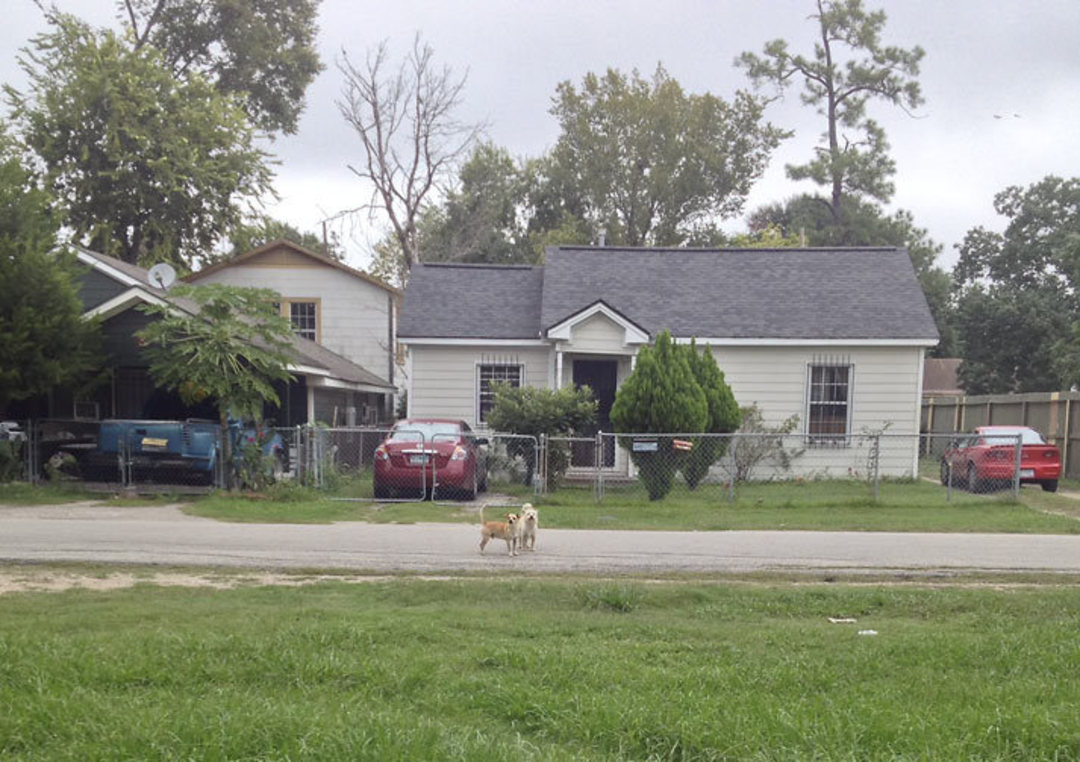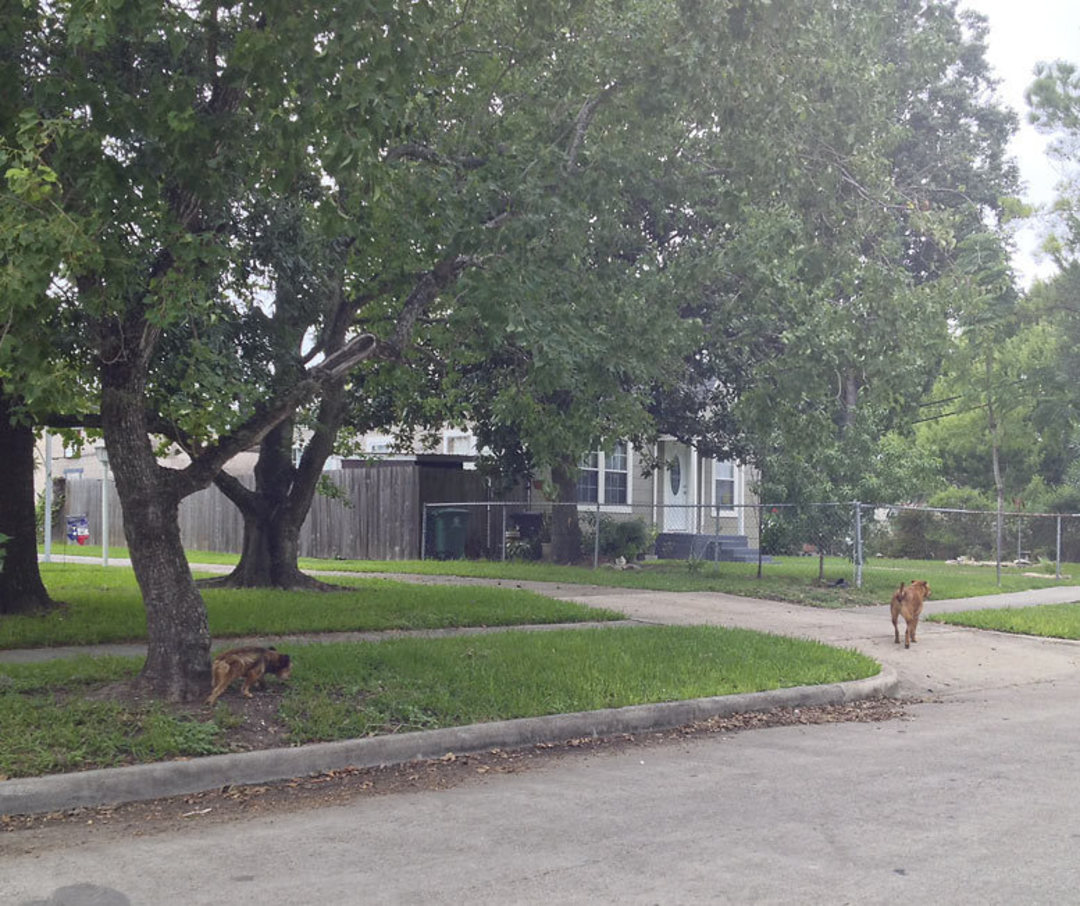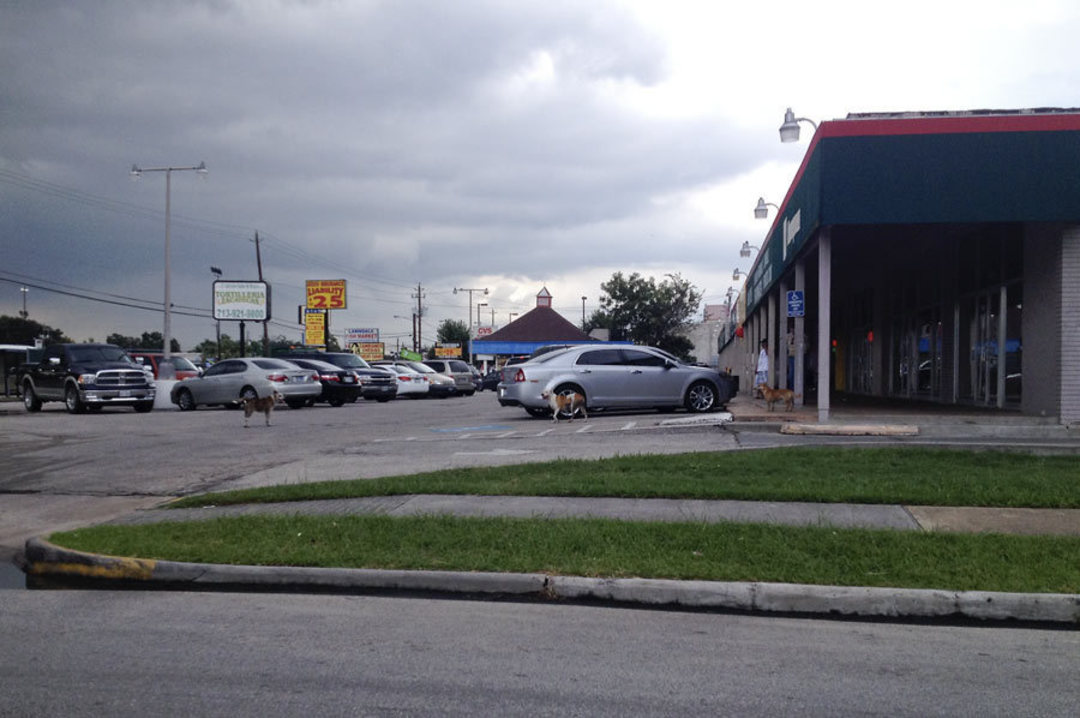Stray Dogs: Menace or Opportunity?

Strays seen near the Harrisburg Hike and Bike Trail
Image: Allyn West
She never saw the dogs coming. Early one Monday morning in July, Maria Arcos was walking down Lyons Avenue from her home to a bus stop on the Southwest Freeway feeder. She was starting a new job. But she never saw the dogs — as many as 20, animal control would later say — coming for her. They knocked her to the ground, tore into her limbs, ripped her clothes, and dragged her down the street.
The conductor of a passing freight train happened to see the attack and called in, but by the time emergency services had shown up, Arcos, in her early 50s, had had a heart attack and lay bleeding and barely conscious.
Said her stepson: “They was eating her. The dogs was eating her to the bone.” It wasn’t clear, even when she had been moved to the hospital, that she would survive.
If you head north from where Arcos was attacked for about 10 miles on the Southwest Freeway feeder, you’ll come to Little York Rd. Some know that street by another name: the Corridor of Cruelty, a phrase coined by Deborah Hoffman in 2008. Hoffman, who went on to found Corridor Rescue, writes about the dogs she’s seen there:
Some have mange, some have broken bones, and some are pregnant. Some are emaciated and all are hungry. Some will come right up to you and some will run the other way. They live in wooded areas and travel through the ditches and across busy intersections. They get hit by cars and keep on going … they scrounge in the few parking lots there are for food scraps. They don’t want to live like this. They are scared and lonely. They want to be saved and have a home.
Little York’s a notorious dumping ground for box springs, couches, TVs. And dogs, alive or dead. In May, Fox 26 reporters went with Corridor Rescue volunteers and counted seven bags bulging with carcasses. Years before that, HPD had installed security cameras that have recently led to prosecutions for cruelty to animals—the first, according to the Houston Chronicle, in Harris County. Footage showed one van slow to a stop, the door slide open, and a pair of Chihuahuas hop out, like kids at a gas station on a road trip, and then chase pathetically down the street as the van peeled away.
There’s no similar moniker I’ve heard to sensationalize the situation in the East End, where I live with my wife—and our dog. Cruelty doesn’t seem to be the right word to describe the attitude here toward the single wayward strays and pathetic packs that trot almost happily through the streets northeast of S. Wayside Dr. to the Ship Channel. My wife and I’ve even named some of them: There’s Munchrat, the puny white yapper who naps in whatever yard he feels like, takes toys from whatever yard has good toys to take. There’s Golf Course Dog, whom we’ve seen lazing like a lion on the fairways at Gus Wortham. And there’re the Red Dogs, the mother-and-son team that so successfully protects their turf that our dog tenses up and refuses to go down their street.
I don’t know what the right word might be to describe the way animals on this side of the Gulf Freeway live. But I do think it’s accurate to call them animals. Not pets. Not necessarily. You don’t see any of them peeking over the edges of designer handbags or wearing cable-knit sweaters, that’s for sure. Most of them live outside, all year, behind chain-link fences. Most seem fed well enough, if not well fed. And it’s not just dogs: If you go north of Harrisburg Blvd. you can often surprise chickens who had been crossing the road into clucking impatiently back toward their drainage ditch where, in other neighborhoods, there’d be a sidewalk. If you head east on Lawndale toward Broadway you can see swayback horses and mules grazing up to the ballast of Union Pacific tracks.

Strays seen near the intersection of Santiago and Alta Vista Street in Forest Hill
Image: Allyn West
Gloria Zenteno grew up here. She’s the founder and president of Barrio Dogs, an advocacy group doing for the East End what Corridor Rescue is doing for W. Little York. Growing up here, though, she says she didn’t see the problem. “It was just part of the neighborhood, part of the culture, to see pregnant mamas, sick animals. The animals ate scraps. They never came inside. They never went to the vet.” When she moved back to Houston to work in Uptown, she would see the well-groomed dogs there paraded around on leashes—pets—and, she says, “felt like I was living in a Third World country.”
That was 10 years ago. Since then, Zenteno has been directing Barrio Dogs. Volunteers, they speak at civic clubs, elementary schools, churches, trying to educate as many East Enders as they can. About spaying and neutering. About reporting abuse and neglect. About what it means to care for animals. Earlier this month, Barrio Dogs organized a kind of neuter-a-thon at Broadmoor Park, canvassing the neighborhood and inviting anyone to bring his pet down for a no-questions-asked snipping, free of charge.

Strays seen in the strip center on Lawndale near 75th Street
Image: Allyn West
Last year, Barrio Dogs spayed or neutered 205 dogs. This year their goal is 333. And what else are you supposed to do? Houston’s a city where every cause is argued as though it should be a priority. Law enforcement, says Zenteno, is overwhelmed. Shelters are full. Corridor Rescue encourages people, when we see an “approachable” stray, to pick it up, take it to the vet, get it shots, and bring it home. That’s not necessarily feasible, of course, if you rent, or are allergic, or are poor. Or have one already.
What are you supposed to do? “It’s become a public relations problem,” says Zenteno. “It’s shameful.” Despites pleas to do so for years, she says, the city hasn’t taken the problem seriously and now has a catastrophe on its hands. BARC estimates that there are about 1.2 million strays in the city. “And it’s getting worse,” Zenteno says. “Not better.”
Maria Arcos was in the hospital for about a month; for two weeks of that time she lay in a medically induced coma. Released in August, she still has a number of surgeries to go, and her doctors told ABC's Channel 13 that she might never walk normally again. “I’m terrified,” she says. It’s hard to blame her for that.
And the dogs that attacked her? BARC found that the pack had been using for shelter an abandoned funeral home about a block away. Some might have had rabies, at least the ones that had dominated the group, but the behavior, shocking though it might seem, is unmistakable: These dogs acted the way desperate animals have always behaved—and it’s hard to blame them for that, either. They weren’t anyone’s pets: These were animals that had gone wild, and we’d put them in a position in which that was inevitable.
BARC set up traps around the funeral home and, after a few days, captured what they believe is the whole pack. The dogs will likely be euthanized.




